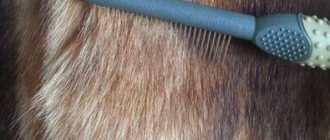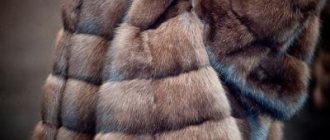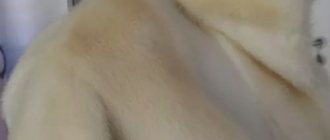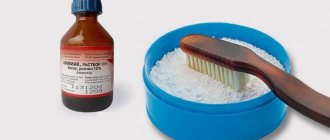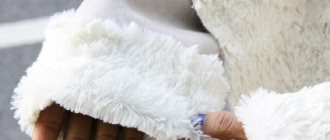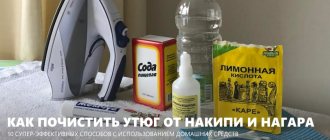04/21/201704/21/2017 Maria Ivanova 1 Comment
How many disputes and problems arise during fur cleaning. This is a very beautiful, but “vulnerable” material that adorns women and, moreover, gives warmth. Many housewives are interested in the question of how to clean fur at home, because they don’t want to spoil a beautiful thing.
With the arrival of spring and warmth, all our warm clothes are sent away to the closet for storage, and of course, before putting them there, you need to carry out mandatory cleaning, which will rid things not only of dirt, but also of pests. When it comes to cleaning a fur coat, many of us immediately trust the professionals.
But as prices become higher and higher, dry cleaning, accordingly, becomes less accessible, and we begin to think about how to clean natural fur at home.
When Cleaning Is Required
The service life of fur products with careful use is at least 10 years. During this time, the fur becomes dirty repeatedly. Untimely and improper cleaning can cause damage. But frequent procedures are not good for fur clothing. There is no schedule that would indicate the frequency of cleaning - everything is individual and depends on factors related to the appearance of the fur.
Cleaning is required if:
- there are spots uncharacteristic of the pile pattern;
- the fur has turned yellow, green or lost its shine;
- the color has lost its uniformity and smooth transitions;
- the pile has become greasy and greasy;
- the flesh became coarser and tougher.
Observe the behavior of the fur in windy weather. If the pile easily fits into its original place, the condition of the product is excellent. Pollution that requires attention is indicated by hairs that, after a blow of wind, do not return to their place, standing on end.
Some tips for caring for white fur
White fur, regardless of origin (both natural and artificial), requires constant careful care, as it quickly loses its attractive appearance due to its soiling.
Therefore, when wearing fur products, you must follow a few simple rules:
- In the spring, at the end of the winter season, before storing your fur coat or hat, you need to clean it of street dirt by wiping it with a clean sponge soaked in a solution of 9% vinegar and water. After this, things need to be air dried.
- Fur items should be stored in a linen bag or wrapped in blue paper so that they cannot turn yellow.
- It is important to take care of keeping things moth-proof. Fresh and dry geranium leaves, orange peels or tobacco, placed in fabric bags in the closet, can help with this.
- Yellowness often appears under the influence of moisture, therefore, if the fur gets wet under snow or rain, it must be immediately vigorously shaken off and dried naturally.
- In the summer, you need to remember to air your fur coats and hats on the balcony from time to time, and also comb the fur so that it does not lose its shape and fluffiness.
If you follow these simple recommendations, white fur items will always retain their original appearance, and you will have to clean them from dirt, grease and yellowness much less often.
Features when cleaning light and dark fur
To wash fur, you need to know which methods are suitable for a specific shade of the product in order to reduce the risk of damage to the product to zero. To do this, you should familiarize yourself with the list of prohibited products.
Exposure to dry compounds is an effective way to clean fur from dust:
- For dark fur, acceptable absorbents are hot sand, rye bran, sawdust and ground walnut shells. They remove dust and dirt from the pile, improving its appearance.
- For white products, cleaning with sand and walnut shells is fraught with staining, so preference should be given to starch, semolina and talc. Talc not only copes with the assigned cleaning tasks, but also neutralizes unpleasant odors.
- It is worth saying that talc is not recommended for dark fur. Small grains can settle on the hairs, which will lead to loss of shine, luster and natural color.
Dry washing powders are not acceptable for fur products of any shade.
Wet exposure is only permissible superficially, without affecting the interior. Light damp cleaning will help neutralize the oily sheen of dark fur. But light shades are more susceptible to yellowing, which cannot be removed without liquid compounds:
- Ammonia and vinegar are allowed for both light and dark products. Prohibited - acetone (the reaction of the lint is very unpredictable).
- Yellowing of light fur can be safely and quickly eliminated with hydrogen peroxide.
- Refined gasoline will help remove greasy shine from dark fur. It is strictly contraindicated for light shades - it cannot be used to restore the snow-white appearance; the condition may worsen, even to the point of irreparable yellowing.
The generally accepted measure for fur of any shade is to comb it with a comb with fine metal teeth. Comb as follows: Short and cut - against the grain, long - in the direction.
Methods for cleaning a mink coat
You can clean a yellowed mink coat at home using a dry or wet method, depending on where the contamination is located, what its area is, and what caused its appearance. The cleaning method is determined by the color of the item: dry cleaning is suitable for all shades, wet cleaning of the item has its own characteristics.
Dry cleaning is the treatment of fur with substances that act as a sorbent. They absorb dirt from the pile of the product. During wear, a lot of substances from the environment settle on a fur coat: exhaust gases, dust, sulfur, soot, soot, the fur cakes, becomes shiny, and has a greasy appearance. The undercoat sticks together and the product does not provide warmth.
Wet cleaning is suitable for treating small area stains and lining. It is strictly forbidden to expose the entire fur coat to water; moisture will damage the fur and leather.
Dry cleaning
Talc, baby powder, and flour will help get rid of grease and soot on your coat. The fur coat is laid out on a horizontal surface, the fur is combed out with a special brush against the hair growth line, sprinkled with loose substance and combed out again. Afterwards, the remaining substance that has collected dirt from the pile is shaken off the coat, and the fur coat is put on hangers.
Sawdust is a means of cleaning fur in industrial conditions. Only sawdust from deciduous trees - aspen, linden, oak - is suitable. Place the fur coat horizontally, sprinkle it with sawdust and comb it against the hair growth line with a brush. The sorbent will collect dirt, dust, soot, and grease from the fur.
Soak the sawdust in purified gasoline or medical alcohol, sprinkle it on your fur coat, and wait until it dries. Afterwards, the item needs to be combed and aired, the fur of the fur coat will shine like new.
Starch has a high fat-absorbing ability. The principle of operation is standard: sprinkle on the fur and comb so that the dirt remains on the starch.
Semolina is an effective method to get rid of traces of wear on a fur coat - comb with grain, which will rid the pile of fat, dust, soot, traces of foundation and sweat on the collar. The fur coat is laid out horizontally, sprinkled with grain and thoroughly combed. The remains of the semolina are shaken off.
Wet cleaning
- The best way to clean a white mink coat is to treat the fur with hydrogen peroxide; for a dark one, you should choose a different cleaning method. Peroxide must be poured into a container with a spray bottle and sprayed on a fur coat hanging on a hanger. After the peroxide has dried, the fur coat must be combed out with a brush. After cleaning with peroxide, the yellowness from the white fur will disappear.
- Gasoline in purified form is used to remove local dirt and stains from a fur coat, in order to restore the whiteness of the fur. For this purpose in 100 gr. liquid add 1 tbsp. a spoonful of starch and apply to the dirt or yellowed area. After complete drying, the remaining cleaning agent is shaken off and the fur is combed with a brush. Whiteness and fluffiness are guaranteed.
- Special products that are sold in stores can easily cope with traces of mink wear. The spray or aerosol is shaken well and sprayed onto the pile of the product. The fur coat should hang on hangers. After processing, the fur is combed with a brush. The product can be selected depending on the color of the fur: for black and brown, for white with a bleaching effect.
- Table vinegar 5%, medical alcohol, vodka easily dissolve any contaminants. To do this, apply table vinegar or alcohol to a cotton pad and treat the stain. Dirt, grease, oil will remain on the disc, and the fur will shine. You can use an aqueous solution of ammonia, applying it to the pile with a cotton swab in a ratio of 1:4, where one part alcohol and 4 parts water.
- To clean a dirty mink coat, regular hair shampoo, which is diluted in water until a thick foam forms, will help. Rub the shampoo foam into the fur with a sponge and wipe with a clean damp cloth. After drying, comb through. Mink has a short pile; it can be combed along the hairline and against it.
Features when cleaning different types of fur
When planning to clean a fur product, carefully consider every step, from information about the type of fur to the nature of the stain. You cannot use one remedy for everyone.
There are recipes and conditions indicated for a specific type of pile:
Mink. Both wet and dry cleaning are allowed, but with gentle handling. Natural mink fur can be cleaned with 9% vinegar, medical alcohol and water. Ingredients in equal proportions. Residues are removed with a dry soft cloth. The solution is convenient when affecting large areas, as it is easily distributed from a spray bottle. A mixture of salt and ammonia will cope well with local problems. When dry cleaning, preference should be given to talc or sawdust, depending on the shade.
Rabbit, goat and wolf. The fur is easy to care for. The most popular method is cleaning with a mixture of ammonia, hydrogen peroxide and water (1 tbsp/3 drops/250 ml). The solution is applied to the product and left for 20 hours. Dry cleaning – with bran heated to 45-50 °C.
Chinchilla, otter, muskrat. Being classified as a dark species allows you to safely clean the fur at home. It is allowed to use pure but high-quality gasoline, as well as solutions based on an equal ratio of medical alcohol, vinegar essence and water. From the list of dry methods, cleaning with hot sand is ideal.
Sheepskin and astrakhan fur. A quick and effective way to clean sheepskin and astrakhan fur is hydrogen peroxide. It is not used in a pure state, but in a diluted state - a liter of water is taken per tablespoon. When applying, make sure that the liquid is distributed over the surface without penetrating deep into the core. Potato starch and aviation gasoline are the way to achieve excellent cleaning results.
Arctic fox, fox and silver fox. The list of acceptable cleaning methods is very long. This includes pure gasoline, shampoos for animals (dogs in particular), liquid detergents for washing silk, ammonia, and semolina. Yellowness is removed using peroxide.
Raccoon. Only dry cleaning or surface wet cleaning is allowed.
All methods are accompanied by mechanical combing and drying in a natural way, away from heating devices and direct sunlight.
Ways to update the appearance of a fur product
If it is necessary to just slightly refresh a fur product, then there are several folk methods by which you can do this quickly and easily:
Using bran
- Heat the wheat bran on a baking sheet or frying pan.
- Distribute them over the fur item using rubbing movements.
- Leave the fur coat in this condition for 15–20 minutes.
- When the time is up, remove the bran and clean the fur.
- This product is more suitable for products made from rabbit or sheepskin.
Hot sand
- Place the fur coat on a flat surface.
- Apply sand to it.
- You need to rub it into your fur coat.
- Remove dirty sand from the product. Carry out the procedure several times until the sand is clean.
Typically this remedy is used for silver fox or arctic fox.
Shampoo for cats
- Dilute the shampoo in warm water and lather it.
- Apply to the fur coat with a soft bristle brush or sponge.
- It is necessary to rub the product into the pile of the product.
- Leave the fur item in this condition for 3–5 minutes.
- Rinse off the shampoo, being careful not to wet the skin to avoid cracking.
This product is excellent for products made from nutria, rabbit and chinchilla.
Birch sawdust
- Soak birch sawdust with turpentine, kerosene or gasoline.
- Distribute them throughout the product.
- Brush your fur coat.
Great for silver fox and rabbit.
Table vinegar and alcohol
- Add vodka and 9% acetic acid and vodka to the water; the ingredients must be mixed in equal quantities.
- Apply the resulting product to the fur using a soft product: a rag or sponge.
- Immediately after this, remove the solution from the product with a napkin.
More suitable for chinchilla and nutria.
What is the difference between light cleaning and deep cleaning?
The choice of intensity of the proposed cleaning depends on the degree of contamination of the fur.
Easy cleaning is used when the product is only slightly dusty and does not have a greasy sheen, yellowness, or unpleasant aroma.
Easy cleaning of natural fur at home can be called a preventive measure aimed at minimizing the amount of cleansing through deep and chemical influences.
To carry out the procedure it is enough:
- Wet the cotton cloth with plain water.
- Spread the material on a flat horizontal surface.
- Place fur on top, for example, a fur coat, pile side down.
- Knock the thing out with a clapper.
- Shake and dry.
The settling of rare dust particles and sand is not a reason for deep cleaning. It is carried out only when the clothes have lost their neat appearance and the fur has become greasy.
Cleaning is carried out in the following sequence:
- Gentle removal of dust using the knocking method.
- Removal of local contamination.
- Combing out dirt using a comb.
- Treat the surface with the selected cleaning agent.
- Repeated combing.
- If necessary, knocking out (indicated for dry cleaning) or drying (for wet cleaning).
For both light and deep cleaning, combing is recommended to maintain the correct direction of the pile.
How to get rid of grease stains
If for some reason grease stains appear on a fur item, experts recommend using aviation gasoline rather than regular gasoline to remove it.
You need to apply a little fuel to the sponge and carefully treat the stains. It does not matter what kind of fur is cleaned, artificial or natural. Gasoline should be applied carefully as the pile grows. After this method of getting rid of grease stains, it is advisable to hang the clothes out in the open air and wait until the smell of gasoline disappears completely.
How to clean fur
Methods also differ based on the type of contamination. Yellowness, dust and grease can only be eliminated with the right selection of products.
Dry cleaning with starch
Starch is a popular absorbent used in cleaning fur.
The reason lies in affordability, security and speed of solving problems with its help.
To increase starch cleaning agents, it is recommended to heat it in the microwave or in a water bath. The maximum permissible temperature of the product is 80 °C.
Cleaning is carried out as follows:
- A large amount of starch is distributed along the front side.
- Using a dry, clean hand or cloth, rub the dry mixture onto and between the pile with gentle massaging movements.
- When the starch loses its whiteness, the product is knocked out to remove residues.
The procedure is repeated until a white shade is achieved - after cleaning, the starch should retain its original appearance. Upon completion, the fur is well knocked out and combed.
Semolina - to restore shine and remove dust
Semolina can surprise - in addition to being used in cooking, it is an excellent helper in the household. For example, it has shown itself to be excellent when cleaning fur: it does not spoil the lint and fur, removes dirt, and restores shine.
Using semolina when cleaning fur:
- Apply the cereal to the surface.
- Rub against the lint.
- When the shade of the semolina changes, begin removing it, combing it moving in the same direction as the pile.
- Shake to remove any remaining product.
Exposure to semolina is a quick method that does not require either heating the ingredients or mixing with other components. The cereal is good on its own. However, if the contamination is serious, it would not be a bad idea to strengthen the semolina by mixing it with gasoline or vinegar. As a result of mixing, the loose texture should be preserved.
Ammonia and hydrogen peroxide - from stains, dirt and oily shine
A multifunctional product aimed at neutralizing a wide range of problems ranging from dirt to oily shine.
Required:
- ammonia – 2-3 drops;
- hydrogen peroxide -1 tsp;
- water – 1 l.
Steps:
- Mix the ingredients and pour into a spray bottle.
- Distribute the solution over the surface.
- Remove dirt with a soft cloth and combing.
Don't forget to dry it properly and comb out the lint periodically.
Wheat or rye bran
Bran is not only a cleaning agent that removes dust, dirt and grease, but also a natural fragrance that eliminates unpleasant odors.
Application:
- Heat the bran in a dry frying pan.
- Distribute while hot on the surface.
- Distribute against the pile using massaging movements.
- Leave until cool.
Hot bran will quickly absorb dirt and grease, and all you have to do is shake out the product.
Shampoo for animals
It is logical to use detergents designed specifically for caring for pets when cleaning fur.
Suitable shampoos for cats and dogs. The recipe that uses shampoo is very simple and also includes water.
Cleaning:
- Dilute shampoo in a small amount of water.
- Beat until soft, fluffy foam is obtained.
- Apply foam to the area to be treated.
- Rub in with a soft sponge.
- Remove with a damp cloth.
- Brush and dry.
It is acceptable to use regular shampoo and dishwashing detergent. Only without aggressive components.
Household chemicals – compositions for cleaning fur
AVEL Hussard
InSaf
If you can’t trust traditional methods, take advantage of the gifts of chemical products. Fortunately, there are now a sufficient number of special compounds.
The following products have proven to be effective and safe:
- Ultra Finish Milk. Used to remove dust, add shine, restore softness and silkiness. Does not cause sticking. Simply spread over the surface and dry.
- AVEL Hussard Terre De Sommieres. Presented in powder form. Works great on greasy and oily marks. The only drawback is the price, which starts from 600 rubles. It is used like starch - spread, rub, knock out.
- InSaf. It has a wide range of effects - from antistatic properties to removing dirt and dust. Price from 150 rub.
Acceptable household chemicals do not include powder.
Rules for cleaning and storing products
When cleaning mink fur, there is a high risk of being careless or not taking into account the characteristics of the substances used. Actions that are undesirable when caring for an expensive product:
- Washing coats is strictly prohibited. Under the influence of detergents and water, it will lose its shape, the skin will become rough and dry.
- Do not use a hair dryer when cleaning wet.
- Under no circumstances should an iron be used during the drying process. The product will retain its natural shape if you use regular hangers.
- You should clean your mink coat only when necessary. Too frequent procedures may cause fur shedding.
To avoid the problem of how and how to clean a mink coat at home before each winter season, you need to follow several rules. They are quite simple:
- You cannot store a fur coat in a plastic bag so that the pile does not become electrified and oxygen deficiency does not form;
- Before long-term storage of products, it is recommended to treat cabinets with special products that will protect the fur coat from pests;
- you can stuff your sleeves with newsprint: moths don’t like the smell of printing ink;
- Before storing a mink coat, you need to ventilate the room and put a bag of incense in the closet;
- Mink fur should not be sprayed with perfume to avoid stubborn stains;
- you should give up the habit of carrying a bag on your shoulder or on your arm: this is a sure way to dry out the fur.
For today, that’s all I wanted to say about how to clean a mink coat at home. And if you follow simple rules and provide the fur coat with proper care, then this expensive and beautiful thing will last a long time. It is advisable to monitor the condition of the mink coat in the summer.
Is it possible to wash real fur?
When wondering about the permissibility of washing, feel free to reject any urge to such actions. Washing natural fur is prohibited - both by hand and in a machine. The mezdra, the so-called skin on which the pile rests, can become rough and crack when wet.
Deformation and baldness are the consequences of washing natural fur in a washing machine. The villi are pulled out of the skin, and deformation occurs not so much from exposure to temperature as from a humid environment. Therefore, even when carrying out wet washing, you should be extremely careful not to apply more solution than is required for surface cleaning.
Washing for natural fur is taboo. Other prohibitions include: drying with a hairdryer, in the sun and near heating devices; Ironing even from the inside out.
Home Remedies for Cleaning Fur
There are several simple ways to clean light natural fur.
Starch
Starch is used to return the fur to its original white color. Pour powder onto the product and use a dry wash.
This is done in the same way as with a simple wash, only without water. The fur needs to be rubbed well, but not more than 10 minutes. Then the starch is shaken off, and the remainder is combed out using a brush with natural bristles.
This technique is used for white fur and collars with colored, natural fur.
Ammonia
For this method you will need ammonia with hydrogen peroxide. The mixture is prepared as follows: add 1 teaspoon of peroxide and a few drops of alcohol (you can use vodka) to 200 ml of water. The solution is poured into a sprayer, after which the product is processed from a short distance.
After cleaning, the fur must be dried at room temperature. The product should absolutely not be hung to dry on radiators or heaters.
How to remove stains from fur
On fur products, as on other things, stains often appear that have a different nature of origin.
Fur can become stained, for example, from interaction with suede surfaces. It is also possible that stains may appear due to simple carelessness - blots from a pen, traces of sauces.
Problems with spots are solved based on the type of fur and its shade:
- Dark fur is restored to its original appearance with gasoline. It will remove grease from the collar and cuffs. It can be used both in pure form and in diluted form. Mix gasoline, starch or finely ground sawdust in equal parts - you should get the consistency of sour cream. Apply to the stain, wait 5 minutes and remove.
- The ink can only be removed with acetone, but given the unpredictable reaction, test drive it in an inconspicuous area.
- The problem that arises on light fur can be solved by mixing alcohol with starch or soda.
- Oil paint stains can be removed with vegetable oil.
- Lipstick, foundation can be used with medical alcohol.
- A mixture of ammonia and salt can deal with stains from grease and sweat.
If home treatment is not successful, the only way out of the situation is dry cleaning. Trained specialists will assess the situation and, based on the type of fur, type and complexity of the stain, will carry out dry cleaning with professional means.
Vinegar
When you look at the cotton wool, you will understand that it was not in vain that you chose this method of cleaning. The cotton pad will darken with dirt and will have to be replaced with a new one. Replacement must be carried out until you completely clean your fur coat, hat or collar.
Natural hair is not afraid of vinegar, but if there is a need to soften it, use diluted glycerin. This will make it shine even more and will be protected for some time by a thin film. After wet cleaning, it is advisable to comb the fur and give the product time to dry completely. Only then put it in a case and put it in the closet.
Please note that it is very important to regularly wear a warm fur coat. The more often you go out into the cold in it, the longer and better it will last.
But in wet weather you need to wear a jacket and take care of fur items. If you accidentally get caught in the rain wearing a fur coat, hang it on a hanger, comb it and leave it to dry. Under no circumstances should it be placed near heaters or in very hot rooms.
Source
Additional recommendations
When cleaning light and dark fur, there are a lot of nuances, if not followed, the procedure can harm the appearance of the product. Fur may fade, losing its natural shine, if you clean a dark item with an overly concentrated solution of ammonia. And light shades are often susceptible to yellowing, which is often the cause of improper drying and selection of cleaning products.
What not to clean
The list of funds permitted for use has already been discussed several times. But a separate topic worth mentioning is the effects of substances that are unacceptable in relation to natural fur.
These include:
- household chemicals for rust removal;
- enzyme powders;
- bleaches;
- substances with an aggressive composition.
If you think that the problem cannot be solved without strong remedies, do not take risks and entrust the product to professionals working in dry cleaners.
How to get rid of dust
If the product becomes dusty during storage (the case does not provide 100% sealing), you should not immediately resort to drastic measures. There is a method that can quickly neutralize the problem.
First, try to solve everything peacefully using mechanical force - knocking it out with a clapper or using a vacuum cleaner for the keyboard.
If knocking out didn't work:
- Spread a cotton cloth lightly moistened with water on the floor.
- Place the product on top and knock it out on both sides.
Don't forget to comb it after cleaning. But don’t get carried away; excessive combing will not benefit the natural hair.
How to restore shine to fur
Loss of shine can be caused by both use and cleaning. Effective methods for restoring shine are:
- Treatment with lemon juice and table vinegar (1/1).
- Grated walnut kernels - the desired result is achieved thanks to the oil.
- Fish oil (100 g) in combination with laundry soap (10 g), boiling water (1 l) and alcohol (10 drops) will clean and restore shine. Processing while cooled.
- The return of shine is guaranteed by treatment with a vinegar solution.
A washing solution based on neutral hair shampoo and water will be a real salvation from oily sheen, which is unnatural for fur.
Having studied all the nuances and cleaning methods, you don’t have to worry about reducing the service life of the fur product.
How to wash the lining?
Fur does not tolerate rough handling, so remember the rules that cannot be broken if you do not want to completely ruin the product.
- Washing natural fur products entirely at home, whether of natural or artificial origin, is strictly prohibited. Wash faux fur on a delicate machine wash cycle without spinning.
- Fur should not be dried at high temperatures: only in the open air or in a well-ventilated area.
- Fur should not be ironed.
- Fur is sensitive to household chemicals and harsh products, so you should not experiment with bleaching agents.
But before you start washing or dry cleaning the product, determine the type of problem.
Natural fur coats are not recommended to be washed. This procedure will not only ruin the pile, but also the leathery base of the fur, when dry, will shrink a couple of sizes, which will lead to sagging of the lining and deformation of the clothing as a whole.
Is it worth the risk of ruining an expensive item? Some manufacturers allow their products made from artificial fur to be washed.
Particular attention should be paid to the meaning of the pictograms on the tag and remember a few rules:
- wash in slightly heated water (temperature up to thirty-five degrees);
- do not use regular washing powders;
- do not squeeze;
- Do not dry on hangers.
If the contamination is extensive and cleaning methods at home are powerless, dry cleaning can be a panacea. It should be borne in mind that the services of this organization cost a lot, and not everyone provides a guarantee of a good result.
You should only trust your furry treasure to trusted companies with a good reputation; having previously discussed all the nuances of the procedure, be sure to document the provision of the service.
You can clean the lining of your fur coat using one of the options:
- without separating the lining from the fur coat, turn the product inside out and clean individual areas - used if the problem area is small;
- tear off the lining, wash, dry, iron and sew again - used for heavy soiling.
When cleaning the lining directly on clothing, you should dissolve the shampoo in warm water, apply the solution to problem areas with a sponge, rub, pulling the lining so as not to wet the base of the fur coat. Blot wet areas with a dry cloth and dry, leaving the fur coat inside out.
In another case, the lining is soaked in warm water with liquid washing powder for twenty minutes, after which it is washed by hand, rinsed well and air dried. Do not wash it in a machine or dry it on a radiator - the fabric may shrink.
Particularly stubborn stains on the lining can be removed using dish soap or a solution of ammonia.






